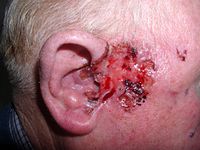
Photo from wikipedia
Significance Oral cancer is often diagnosed at late stages, resulting in a poor prognosis of this disease. Understanding early carcinogenic events taking place during the development of oral cancer is,… Click to show full abstract
Significance Oral cancer is often diagnosed at late stages, resulting in a poor prognosis of this disease. Understanding early carcinogenic events taking place during the development of oral cancer is, therefore, an important unmet clinical need. This study identifies an early anticancer protective role of oral Langerhans cells (LCs), the principal mononuclear phagocyte involved in immunosurveillance of the oral epithelium. Continuous exposure to the carcinogen 4NQO hampers the local differentiation of LCs, while other mononuclear phagocytes and T cells with immunosuppressive characteristics populate the epithelium, leading to the development of oral cancer. These findings reveal an initial step by which immunosurveillance is compromised by a carcinogen, which could facilitate novel diagnostic approaches to better detection of oral cancer. Early diagnosis of oral squamous cell carcinoma (OSCC) remains an unmet clinical need. Therefore, elucidating the initial events of OSCC preceding tumor development could benefit OSCC prognosis. Here, we define the Langerhans cells (LCs) of the tongue and demonstrate that LCs protect the epithelium from carcinogen-induced OSCC by rapidly priming αβT cells capable of eliminating γH2AX+ epithelial cells, whereas γδT and natural killer cells are dispensable. The carcinogen, however, dysregulates the epithelial resident mononuclear phagocytes, reducing LC frequencies, while dendritic cells (DCs), macrophages, and plasmacytoid DCs (pDCs) populate the epithelium. Single-cell RNA-sequencing analysis indicates that these newly differentiated cells display an immunosuppressive phenotype accompanied by an expansion of T regulatory (Treg) cells. Accumulation of the Treg cells was regulated, in part, by pDCs and precedes the formation of visible tumors. This suggests LCs play an early protective role during OSCC, yet the capacity of the carcinogen to dysregulate the differentiation of mononuclear phagocytes facilitates oral carcinogenesis.
Journal Title: Proceedings of the National Academy of Sciences of the United States of America
Year Published: 2022
Link to full text (if available)
Share on Social Media: Sign Up to like & get
recommendations!